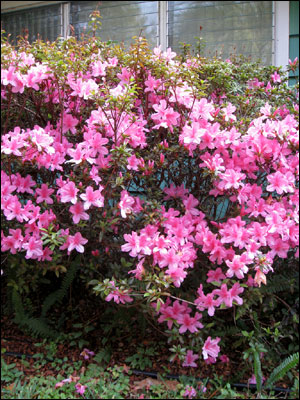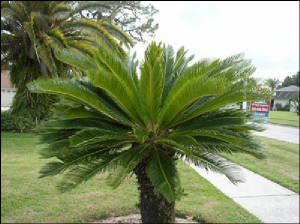|
|
 |
|
Gardening Blog
|
 |
|
|
Sunday, August 15, 2010
Plants Dangerous to Pets
We
all like to have lovely landscapes and houseplants, but, if we have pets, there are some plants that can be toxic to them
if eaten.

There are some plants that can be deadly if consumed by pets; azaleas, cycads or sago palms, and oleanders.
Others can make animals sick. We are usually familiar with the Dieffenbachia or dumb cane dangers since they affect
humans too. Chewing on this plant can lead to suffocation because the Calcium Oxalate crystals in the plant
tissues cause the throat to swell. But, there are many more common plants that are used in the landscape
and as house plants that can cause distress for our pets. Some of the common house plants are aloe, amaryllis, caladium, peace
lily, calla lily, elephant ears, philodendron, antherium, and pothos. Cats are particularly sensitive to lilies like daylilies
and crinum lilies. Other plants that we use in our landscapes that can be toxic include; dracaena, kalanchoe, hydrangea, lantana,
yucca and iris. Even tomato plants are toxic.
The Veterinary Pet Insurance Company
released a top 10 list of plant poisoning claims. While raisins and grapes caused
the most problems along with some other edibles, many of our familiar plants are on the list.
Number
4 is Lily - the poisonous component for cats has apparently not been identified. Even ingestion of very
small amounts of a lily plant could result in severe kidney damage.
Number
7 is Sago Palm - All parts are poisonous, but the seeds contain the largest danger.
The ingestion of just one or two seeds can result in vomiting, diarrhea, depression, seizures and liver failure.
Number
9 is Azalea - ingestion of a few leaves can result in serious effects that typically occur within a few hours after
ingestion and can include acute digestive upset, excessive drooling, loss of appetite, diarrhea, depression and weakness.
Number 10 is Hydrangea – ingesting parts of this plant can result in a gastrointestinal
disturbance with vomiting, depression, and diarrhea.
 If you have pets and also have any of these problem plants, use common sense. If your pet does not usually
choose to chew on plants, then it shouldn’t be a problem. If you have a dog or cat that likes to
dig, then Amaryllis, caladiums, and other bulbs may not be appropriate for your landscape since they might dig them up and
decide to chew on them. You could consider removing the toxic plants or fencing the area off to the pet.
Several of the plants I listed are also used as house plants and that could create a problem. Sometimes
animals, especially dogs, which are bored, will chew just for the fun of it. If you choose to keep the
plants, familiarize yourself with the symptoms that a pet may show if they ingest one of these plants and seek help immediately
if your pet shows any of these symptoms. If you have pets and also have any of these problem plants, use common sense. If your pet does not usually
choose to chew on plants, then it shouldn’t be a problem. If you have a dog or cat that likes to
dig, then Amaryllis, caladiums, and other bulbs may not be appropriate for your landscape since they might dig them up and
decide to chew on them. You could consider removing the toxic plants or fencing the area off to the pet.
Several of the plants I listed are also used as house plants and that could create a problem. Sometimes
animals, especially dogs, which are bored, will chew just for the fun of it. If you choose to keep the
plants, familiarize yourself with the symptoms that a pet may show if they ingest one of these plants and seek help immediately
if your pet shows any of these symptoms.
This list is not complete. If
you are concerned about any plants, do some research at the library or on the Internet. If you still have questions consult
with your veterinarian.
The ASPCA web
site has comprehensive searchable information about plants that are toxic or non-toxic to pets: http://www.aspca.org/pet-care/poison-control/plants/.
6:26 pm edt
Sunday, August 8, 2010
Southern Chinch Bug Management in Florida
I
have gotten many questions about Chinch Bug control lately and the University of Florida/IFAS Extension publication below
outlines the latest research information about controlling these pests in your St. Augustine grass.
What are chinch bugs and why are they killing my
St. Augustinegrass lawn? Chinch bugs are small insects (1/8th inch long) with
straw-like mouthparts that feed on the fluids in grass plants. Immatures (nymphs) and adults feed in groups while hidden at
the base of the grass. Infested turf eventually grows slower, yellows, then dies in small patches. The speed of turf death
probably depends on chinch bug density and the turf’s overall health (stressed grass will likely die faster).
Why are chinch bugs hard to control?
· The insects and/or their damage could be easily misdiagnosed. Scalping, animal urine, diseases,
drought and other things can cause dead spots in St. Augustinegrass. Make sure the insects are present in the thatch.
·
Each year, chinch bugs
have 3-10 generations (active from April to October in northern Florida, nearly year-round in southern Florida). All life
stages (eggs, nymphs, adults) are present at the same time. Current insecticides only kill nymphs and adults, so eggs can
still hatch and produce another generation. Chinch bugs usually complete their development from egg to adult in 5-6 weeks.
One adult female can live 1-2 months and lay up to 300 eggs.
· Natural enemies (e.g., big-eyed bugs, spiders, a parasitic wasp, and others) are not abundant
and efficient enough to keep chinch bug populations under complete control, all the time. However, insecticides can kill them.
·
Some insecticides bind
tightly to organic matter (e.g., leaf blades, thatch) if they are not applied with enough water volume or are not irrigated
soon after an application. The insecticides must get to where the insects are living and feeding to be effective (not stay
on the grass blades or go down to the soil, if the plant crown is the target area).
· Most insecticides used against chinch bugs break
down within 2 months or less, and might need to be reapplied. Some factors that affect the length of insecticide residual
include pH, soil type, and amount of thatch.
· The insecticide dose may not be correct. Be sure to follow label instructions to apply the
right amount of product.
· Some chinch bug populations have been repeatedly treated with similar insecticides for years. A few
chinch bugs may survive each treatment, lay eggs, and pass on their ability to tolerate the insecticides. Since chinch bugs
don’t move far, insecticide tolerance/resistance may be localized to areas that have been under long-term, intensive
lawn care.
·
Heavy fertilization may
lead to excessive thatch build-up and provide chinch bugs with better quality food, so they may develop faster, more of them
may survive, and females will lay more eggs.
Should
I work with a professional lawn service or manage the lawn myself? ·
Commercial applicators
are trained to correctly identify pests, and can better manage pests with properly timed applications of products known to
be effective.
·
Some new insecticides
and certain formulations of older ones are not available to homeowners, so only professional applicators can buy them.
·
If a lawn has a history
of infestation, consider doing one spring and maybe a late summer application to keep pest numbers low. Fewer applications
mean that natural enemies can live to help suppress pests.
· Lawns treated with insecticide <3 times each year are less likely to have pesticide-resistant
chinch bugs.
What can I, the consumer, do to help?
· Notify your lawn service before chinch bugs are abundant and turf damage becomes severe.
·
Turn on the irrigation
after an application has been done, if directed to do so. · Make sure your irrigation system is functioning properly. Chinch bug damage resembles drought
stress.
·
Please understand that
lawn care is a service industry, and they are doing their best to ensure that you have a lawn that you can safely enjoy. Switching
companies in the middle of a resistance problem helps to perpetuate the issue.
What is the industry doing about insecticide-resistant chinch bugs?
· Where resistance is suspected, insecticides with different modes of action should be rotated.
Based on UF testing, consistently effective treatments have at least 1 of these ingredients: bifenthrin, carbaryl, clothianidin,
or trichlorfon.
· High label rates of these insecticides might be used to ensure that most of the “resistant” chinch
bugs are killed. This may, however, increase the cost of chinch bug control.
· UF researchers are studying how cultural and biological controls affect chinch bug populations.
|
|
To subscribe to this blog - click on XML icon.
|
 |
|
|
|
 |
|
|
Pampered Gardeners LLC * Oldsmar, FL * USA * Phone: 727 483-3783 * pam@pamperedgardeners.com
|
|
|
 |

